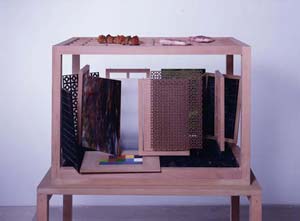Open Grill-House with the Otto Story and Colour Map
Using a model, the open grill-house tries to combine one function of housing, namely the creation of warmth, with
a fundamental need, namely food preparation. The size of the architectural model corresponds approximately to
the size of an actual family or party grill upon which no less than twenty different pieces of meat can be grilled
simultaneously.
If we were to forgo the use of the model as a grill and instead look at it as an actual model in a larger context (for
example: With respect to the use of flammable materials), the architectural difficulties are placed in the foreground: The history of architecture shows us that each increase in the level of cultural development brings a corresponding decrease in the threat posed by a possible enemy, so that people could afford to build with ever increasing openness. We have been lead out of the cave, through the fortifications of the citadel and castle to the
country estate without an external wall, and then finally to modern glass architecture, where no walls at all seem
to block the way to the outside. The outside is no longer to be understood as a danger zone. It is instead the
necessarily accessible domain of all things desirable.
At the apex of this development, where architecture poses new questions about housing (including the question
of the possible conditions of its dispensability) stands a building without walls, with a glowing floor and an open
roof-rack. The traditional protective function of architecture is transformed in this free space of transgressed life
into a memory-filled shadow-play: The meat on the roof moves as a shadow of thick clouds over the ground, while
the hanging window-frames, doorposts, glass panes and confessional screens move freely in the wind.
 We mustn't exclude a possible inhabitant named Otto. However, to balance out his absence, a hungry guest,
costumed as an observer; could approach the actual grill or the model architecture. He is perhaps not interested
in a mere shadow-play, but wants to experience the entire spectrum of what he sees before him. As a measure
of the proper reproduction of reality, a colour map has been provided, with which one can master the moods
within the artificial free space without having to enter the space itself.
We mustn't exclude a possible inhabitant named Otto. However, to balance out his absence, a hungry guest,
costumed as an observer; could approach the actual grill or the model architecture. He is perhaps not interested
in a mere shadow-play, but wants to experience the entire spectrum of what he sees before him. As a measure
of the proper reproduction of reality, a colour map has been provided, with which one can master the moods
within the artificial free space without having to enter the space itself.
Texts Without Verbs, Cologne 2002, p. 132